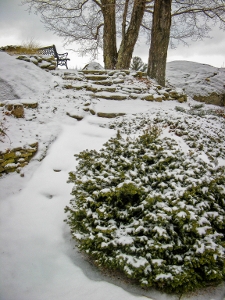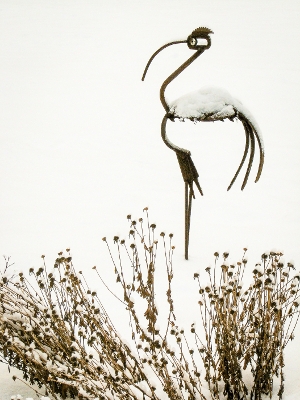Outside my cottage high in the mountains of Vermont, snow is piled up to the window boxes. Crystals of ice catch the morning sun and reflect light over the landscape, while a flock of small birds is already at work breakfasting on the bright red berries of the holly I planted beside the front steps last spring.
Opening the door for our Westie to leap out into the snow and plow a path toward the trees, I look out at the hollies, hemlocks, maples, birch, and a variety of shrubs and grasses framed by the doorway—then offer a small prayer of gratitude for the sweet moment of crisp mountain air, the tiny terrier and the glorious sun filtering through the pines.
The Five-Minute Fix

Winter in Vermont is tough. It lasts for six dark months every year and mountain temperatures can plummet 10, 20, even 30 degrees below zero between late December and early February.
Most of us who live here take the cold and dark in stride. But that’s because we plan for it. As temperatures start heading toward zero, we check our woodpiles and generators, load up on flashlight batteries, canned goods and candles, then strategize how we’ll fend off the moodiness, snarliness, sleepiness and depression that the coming darkness can precipitate.
Some of us climb on skis, snowmobiles, sleds and skates, and throw ourselves down mountains and onto ice-bound lakes. Others schedule vacations in sunny climes. And still others create a winter landscape—a “winterscape”—of shapes, textures, colors and lights that we can see through the windows of our houses, apartments, condos and businesses.
Playing around with your yard may sound like an odd way to fight the moodiness of winter, but studies from the University of Michigan, Texas A&M, Sweden’s Uppsala University, the University of Illinois at Urbana-Champaign, and the Norwegian University of Life Sciences all suggest that even just a glimpse of trees, shrubs and grasses through a window triggers a change in the electrical activity of the brain that measurably improves mood. And it does so within three to five minutes.
Creating the Winter Garden
Most of us are probably more accustomed to thinking about landscapes around our homes and workplaces in terms of how they frame a house or building, or how they look to others from the street.
But Vermont Certified Horticulturist and landscape designer Judith Irven has long felt that the view from inside your home or workplace to the outside is an opportunity to create art. “I’m always reminded of the 18th century poet Alexander Pope, who said that ‘All gardening is landscape painting,’ ” says Judith. “So when I look through my windows into the winter garden, I’m always thinking of making paintings.” The scene through the glass becomes her canvas, the window frame defines it, and on her palette is light and shadow, shape and texture, browns and blacks, plus an occasional splash of red, green or yellow.
“The winter landscape is spare and elegant,” says Judith, who founded Outdoor Spaces, a garden consulting firm, in Goshen, Vermont. “We can actually see the bones on which it’s built without masses of colorful flowers to distract. So whether you live in a canyon in California, a rain forest in Oregon or the high mountains of Vermont, winter is the time to go out and look around, then think about the landscape paintings you want to create.”
Simple Steps to Transformation
Judith’s approach is one that appeals to the artist in each of us. And with the promise that each garden painting we create has the potential to lift us away from winter’s darkness and into the light, here’s how to get started on your own work of art.
Take a tour. Look out the windows through which you’d like to see into your own landscape paintings, and take a photo of the scenes on which you’d like to focus, Judith suggests. Print each photo on an 8½-by-11 inch sheet of paper, and put a sheet of tracing paper on top. That will be your working sketch. Then grab some orange-tipped flags to stick in the ground, pull on your Wellies, slip into a warm coat and head outdoors.
 Look at the shapes. Walk around the area in each photo. Look at where the edges of garden beds are currently located. Are you happy with their shapes? Does one bed take up too much of the window photo? Should it be smaller? Should it curve in one direction or another? If so, says Judith, stick some flags in the ground to reshape the bed’s edges and mark the changes you’d like to make.
Look at the shapes. Walk around the area in each photo. Look at where the edges of garden beds are currently located. Are you happy with their shapes? Does one bed take up too much of the window photo? Should it be smaller? Should it curve in one direction or another? If so, says Judith, stick some flags in the ground to reshape the bed’s edges and mark the changes you’d like to make.
Tinker with structure. Now head back indoors, pull out your photos, and draw the revised shapes on your working sketch. Think about vertical structures like trees and shrubs. Is there a particular spot where you’d like to see a vertical shape thrust upward from surrounding shrubs?
Think about the size you’d want it to be, then look online or in books at trees and shrubs that might work in that particular spot, Judith advises, paying particular attention to the tree or shrub’s size when it reaches maturity. If you’d like to see the field beyond the tree, buy a tree that won’t grow so tall it will obscure your view from inside your home or workplace. Or if you’d like to obscure a line of recycling bins and trash cans, look for a shrub that will give you both the vertical and horizontal coverage you need when it matures. Then check a USDA Plant Hardiness Map to make sure that any plant you buy will thrive where you live.
Add a sculpture. Tuck a whimsical piece of metal sculpture, a simple rock formation, even a handcrafted birdbath into the scene on your working sketch. What you add depends on the mood you’re trying to create.
The garden framed by the window beside the desk in my study, for example, is on the edge of a forest and bordered by an area of wild grasses, brambles and a jumble of wildflowers. Massed together, it’s a bunch of unruly textures against the rough bark of a pine forest that goes on forever, and in winter, the whole scene has a contemplative vibe. So a simple stone statue of St. Francis quietly tucked into a niche of grasses extends the underlying sense of contemplation—and gives me a deep sense of peace when I look up from my work and out the window.
Use a touch of color. Select a trio of red-twigged dogwood, a patch of sedum ‘Autumn Joy,’ a grouping of winterberries, even a crabapple tree to add a splash of intense color across the spare winter landscape.






